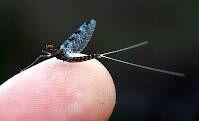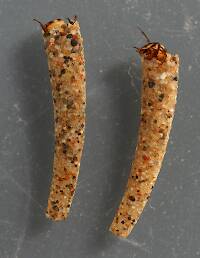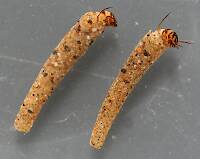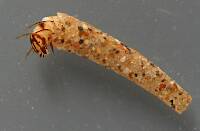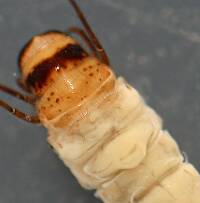
Salmonflies
Pteronarcys californica
The giant Salmonflies of the Western mountains are legendary for their proclivity to elicit consistent dry-fly action and ferocious strikes.
Featured on the forum

With a bit of help from the microscope, this specimen keys clearly and unsurprisingly to Hydropsyche.

Troutnut is a project started in 2003 by salmonid ecologist Jason "Troutnut" Neuswanger to help anglers and
fly tyers unabashedly embrace the entomological side of the sport. Learn more about Troutnut or
support the project for an enhanced experience here.
TDMunro on Aug 14, 2019August 14th, 2019, 4:52 am EDT
I know there are many a want to be entomologists out there that can help me with my Caddis Fly question. I have been out on the river, fishing of course at this time of year, 8/10/2019, and come across a late evening hatch of caddis that are just fascinating. For the life of me I cannot find out which Caddis it is that flies just above the surface of the river in fast zig zag fashion. I am assuming that they are laying eggs at this point but it is always tough to see late in the evening. They seem to be a light shade of tan and also seem to hold their wings out on a 90 degree angle from there bodies. Like I say it's tough to make out at times during that time of the day. From what I have also gathered, every time this happens, the fish are a rising just prior to seeing them, so in turn most likely taking Caddis emergers. I pound the fish at this point. Lovely!!
Can anyone help me here?
This is taking place on northern Michigan streams.
Can anyone help me here?
This is taking place on northern Michigan streams.
Tim Munro
Troutnut on Aug 14, 2019August 14th, 2019, 9:00 pm EDT
Many different caddisflies--probably hundreds of species--behave as you've described. You would have to get some really good photographs of a specimen to narrow it down, or maybe talk to somebody who knows these particular streams at this time of year extremely well.
Jason Neuswanger, Ph.D.
Troutnut and salmonid ecologist
Troutnut and salmonid ecologist
TDMunro on Aug 15, 2019August 15th, 2019, 8:26 am EDT
I should have also said this. The zig zag pattern of this Caddis is not vertical but horizontal just over the river surface, crossing over and under other Caddis, which may include many. This is done at a fairly fast rate of speed. I believe that this is somewhat a one of a kind or maybe a genus of Caddis. A Midwest species. I could be wrong on this but...
I will also say this, I have not seen any other Caddis perform this way and be visable to the naked eye. There is still enough light out to see them when this occurs.
I will also say this, I have not seen any other Caddis perform this way and be visable to the naked eye. There is still enough light out to see them when this occurs.
Tim Munro
Creno on Aug 15, 2019August 15th, 2019, 2:42 pm EDT
If you catch a couple you can get a name on it.
TDMunro on Aug 16, 2019August 16th, 2019, 4:23 am EDT
I believe that I have found out the common name of the Caddis that I am interested in here. The common name would be the Head Light Caddis. Looking into what this little fly may actually look like is like, well I better catch one and lead myself down the taxanomic trail to figure out just which fly this is. I am seeing that this common name is well common throughout the states. May not be the same fly but that name hangs in there. One thing that was stated to me was these Caddis have very long antenna. The flight pattern is just what I stated it to be. Very erratic, zig zag pattern just above the surface of the stream and done in a horizontal way. Very cool. Now every time I have encountered this lovely little Caddis the water is alive with feeding trout. Trout taking emergers. No emerger seems to make it out of the water alive. The fish boil settles down and these Head Light Caddis come out. Right at late dusk. Is it the same insect? Not sure, but there does seem to be a pattern here. During the fish boil I ended up using a #16 green dubbed Caddis emerger and just pounded the fish. Some 15" Browns to boot. Very fun.
Tim Munro
Partsman on Aug 17, 2019August 17th, 2019, 6:11 am EDT
Thanks for the enlightment TD, this is something new to me but that's what makes this website so good. I will be paying attention to these for sure.
Mike
Mike
Quick Reply
Related Discussions
Topic
Replies
Last Reply
0
May 6, 2011
by Jtberez
by Jtberez





